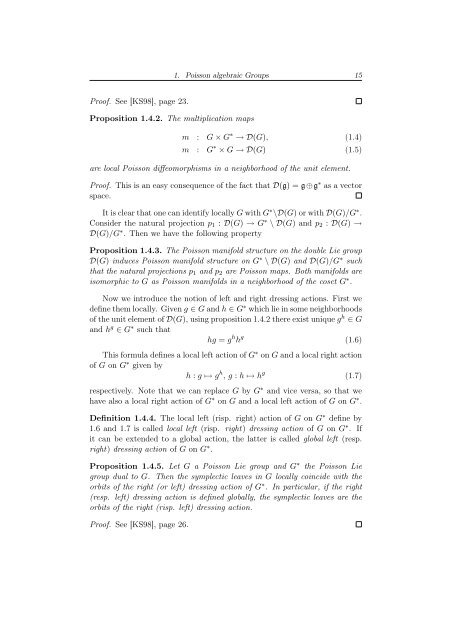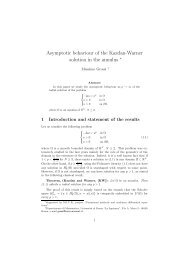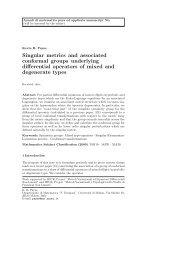Degree of Parabolic Quantum Groups - Dipartimento di Matematica ...
Degree of Parabolic Quantum Groups - Dipartimento di Matematica ...
Degree of Parabolic Quantum Groups - Dipartimento di Matematica ...
Create successful ePaper yourself
Turn your PDF publications into a flip-book with our unique Google optimized e-Paper software.
Pro<strong>of</strong>. See [KS98], page 23.<br />
Proposition 1.4.2. The multiplication maps<br />
1. Poisson algebraic <strong>Groups</strong> 15<br />
m : G × G ∗ → D(G), (1.4)<br />
m : G ∗ × G → D(G) (1.5)<br />
are local Poisson <strong>di</strong>ffeomorphisms in a neighborhood <strong>of</strong> the unit element.<br />
Pro<strong>of</strong>. This is an easy consequence <strong>of</strong> the fact that D(g) = g ⊕g ∗ as a vector<br />
space.<br />
It is clear that one can identify locally G with G ∗ \D(G) or with D(G)/G ∗ .<br />
Consider the natural projection p1 : D(G) → G ∗ \ D(G) and p2 : D(G) →<br />
D(G)/G ∗ . Then we have the following property<br />
Proposition 1.4.3. The Poisson manifold structure on the double Lie group<br />
D(G) induces Poisson manifold structure on G ∗ \ D(G) and D(G)/G ∗ such<br />
that the natural projections p1 and p2 are Poisson maps. Both manifolds are<br />
isomorphic to G as Poisson manifolds in a neighborhood <strong>of</strong> the coset G ∗ .<br />
Now we introduce the notion <strong>of</strong> left and right dressing actions. First we<br />
define them locally. Given g ∈ G and h ∈ G∗ which lie in some neighborhoods<br />
<strong>of</strong> the unit element <strong>of</strong> D(G), using proposition 1.4.2 there exist unique gh ∈ G<br />
and hg ∈ G∗ such that<br />
hg = g h h g<br />
(1.6)<br />
This formula defines a local left action <strong>of</strong> G∗ on G and a local right action<br />
<strong>of</strong> G on G∗ given by<br />
h : g ↦→ g h , g : h ↦→ h g<br />
(1.7)<br />
respectively. Note that we can replace G by G ∗ and vice versa, so that we<br />
have also a local right action <strong>of</strong> G ∗ on G and a local left action <strong>of</strong> G on G ∗ .<br />
Definition 1.4.4. The local left (risp. right) action <strong>of</strong> G on G ∗ define by<br />
1.6 and 1.7 is called local left (risp. right) dressing action <strong>of</strong> G on G ∗ . If<br />
it can be extended to a global action, the latter is called global left (resp.<br />
right) dressing action <strong>of</strong> G on G ∗ .<br />
Proposition 1.4.5. Let G a Poisson Lie group and G ∗ the Poisson Lie<br />
group dual to G. Then the symplectic leaves in G locally coincide with the<br />
orbits <strong>of</strong> the right (or left) dressing action <strong>of</strong> G ∗ . In particular, if the right<br />
(resp. left) dressing action is defined globally, the symplectic leaves are the<br />
orbits <strong>of</strong> the right (risp. left) dressing action.<br />
Pro<strong>of</strong>. See [KS98], page 26.








